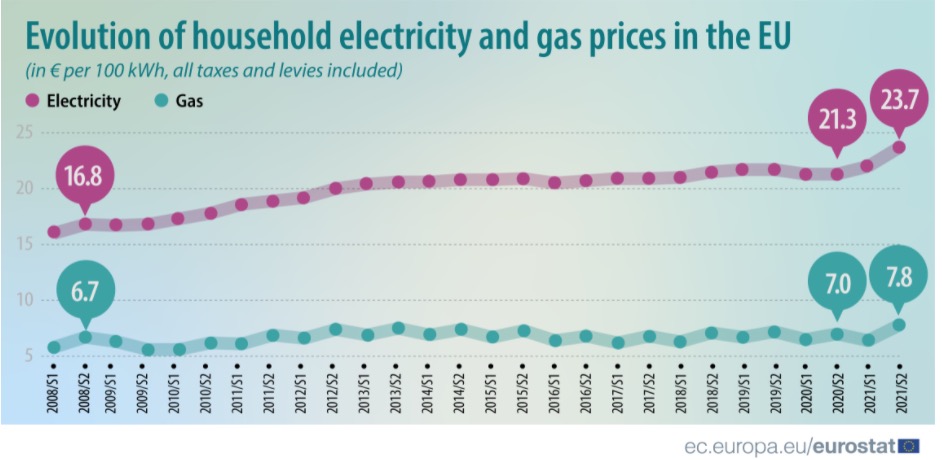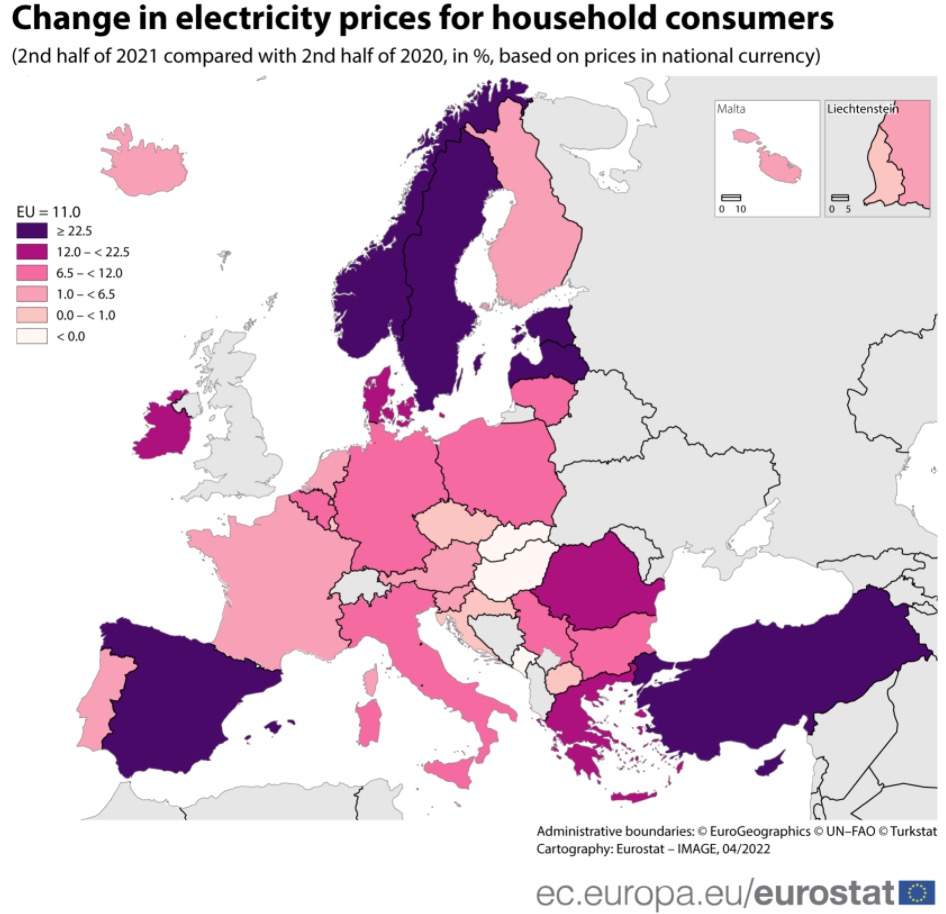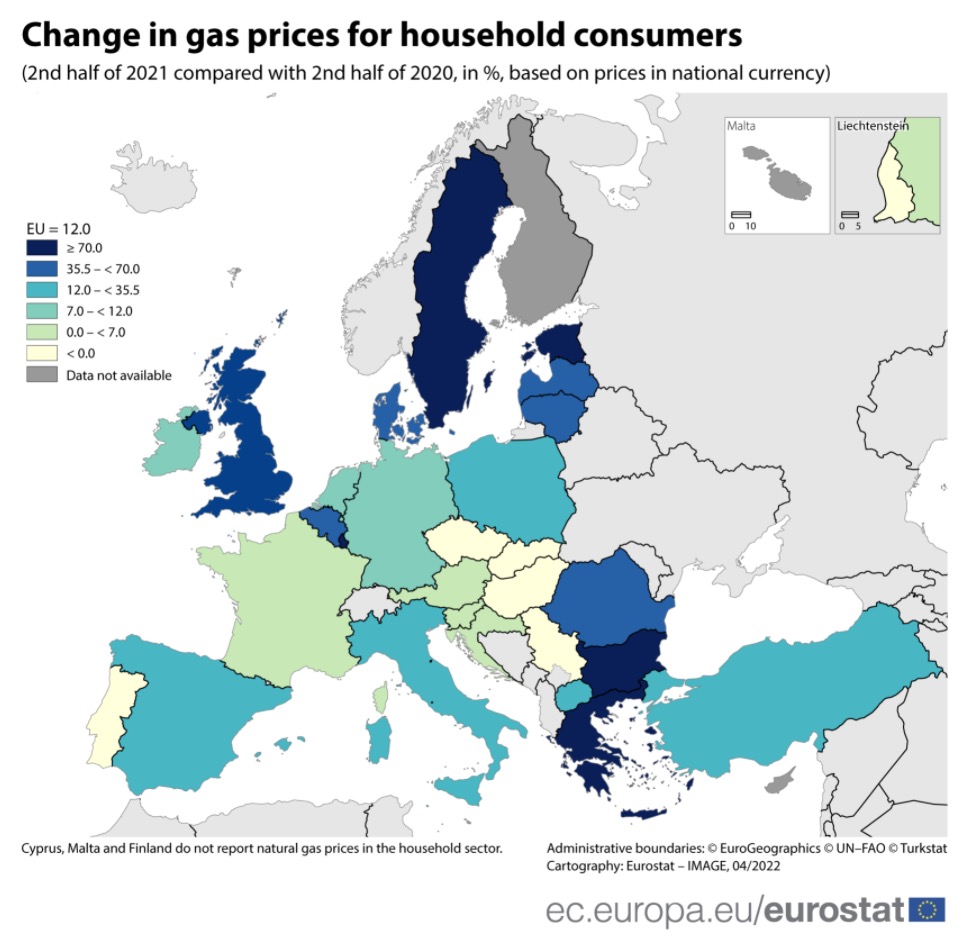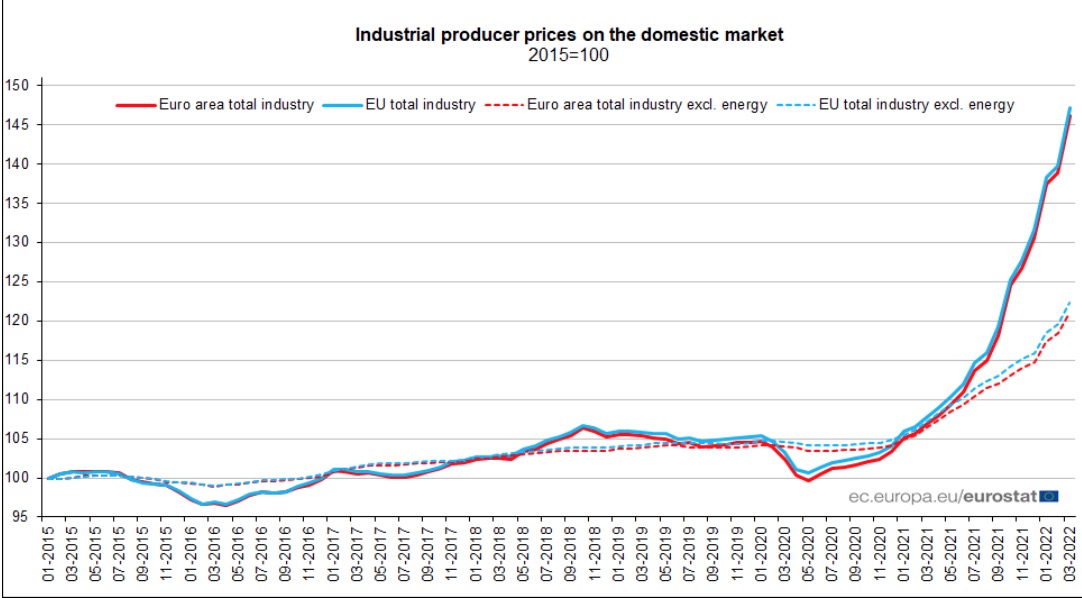In the last winter when the global oil price, gas price and coal price all soared, Europe was the focus area of international energy supply shortage. Due to high dependence on external energy, low natural gas inventories, less than expected new energy output, and fuel price fluctuations being transmitted to electricity prices, many European countries experienced a surge in energy prices in the second half of last year. So, how much of an impact does the energy crisis have on household consumers’ energy bills?
Data released recently by Eurostat show that in the second half of 2021, the average electricity price for EU households increased significantly compared with the same period in 2020, from 21.3 euros per 100 kWh To 23.7 euros (Note: kWh is abbreviated as kWh, that is, the price per kWh is 0.237 euros), an increase of more than 11% year-on-year. Natural gas prices also increased significantly over the same period, from €7 per 100 kWh in the second half of 2020 to €7.8. Recently, wholesale electricity and natural gas prices have risen sharply across the EU, driven by changes in energy and supply costs caused by a number of economic factors.
In the second half of 2021, taxes will account for 36% of household electricity bills and 30% of gas bills, Eurostat said. Compared to the previous year, this price structure has not changed significantly. 
The trend of EU household electricity price (red) and gas price (green) since 2008 (unit: per 100 kWh, including taxes). Image source: Eurostat
Statistics show that household electricity prices rose in all EU member states in the second half of last year, except for Slovakia and Hungary. In the second half of 2021 compared to the second half of 2020, the largest increase (in national currencies) in household electricity prices in the EU-25 will be in Estonia (+50%), followed by Sweden (+49%) and Cyprus (+36%). 
In the second half of 2021, the lowest average household electricity prices per 100 kWh were in Hungary (€10.0, or €0.1/kWh), Bulgaria (€10.9), Croatia (€13.1 EUR), the highest are Denmark (34.5 EUR, or 0.345 EUR/degree), Germany (32.3 EUR), Belgium (29.9 EUR) and Ireland (29.7 EUR).
For natural gas, 20 of the 24 EU member states that reported household gas prices saw price increases. In national currencies, household gas prices rose the most in Bulgaria (+103%), followed by Greece (+96%) and Estonia (+83%). In contrast, only Slovakia, the Czech Republic and Portugal saw gas prices fall. 
EU Changes in gas prices for household consumers, the darker the color, the greater the increase. (The figure shows the year-on-year increase in the second half of 2021 compared to the second half of 2020, based on national currency prices.) Image source: Eurostat
In euros, second half 2021, per 100 kWh The lowest average household gas prices are in Hungary (€3.1), Croatia (€4.0) and Lithuania (€4.1), and the highest in Sweden (€18.6), Denmark (€12.5), the Netherlands (€11.0) and Spain (€10.8 EUR).
Due to the different resource endowments and energy structures of European countries, the impact of fuel price increases on electricity prices in 2021 will vary, with wholesale electricity prices remaining stable in some regions and skyrocketing in some regions.
According to an analysis article by the State Grid Energy Research Institute, for example, Norway, due to 98% of its electricity supply from hydropower and abundant natural gas resources, the overall priceThe fluctuation is small. The average price from January to October 2021 will remain at around 30 euros/MWh. Although the average price in November and December has risen, the average price for the whole year is 35.02 euros/MWh. In Spain, the United Kingdom, France, Germany and other countries, the wholesale market prices have skyrocketed recently. The monthly average price in the market before December has increased by 299%-406% compared with the average price in the first half of 2021.
Taking Spain as an example, from January to June 2021, its daily average market price was EUR 58.58/MWh, and electricity prices have continued to surge since July. In October, the monthly average price of the wholesale electricity market reached 207.49 euros/MWh. In December, the average daily price of the electricity market continued to soar to 239.17 euros/MWh, four times the average price in the first half of the year. On December 23 last year, the single-day wholesale electricity price reached an annual peak of €409/MWh.
The data from the above analysis article shows that in Germany, in June 2021, the average day-ahead market price increased by 40.2% compared with May, reaching 74.33 euros/MWh; Continuing to climb higher, as of December, the monthly average price in the German day-ahead market was as high as 221.06 euros/MWh, an increase of 299.3% over the average price from January to June. The highest single-day wholesale electricity price occurred on December 21, at €431.98/MWh.
It should be noted, however, that a surge in wholesale electricity prices does not equate to an equal increase in retail prices faced by consumers. The changes in electricity prices on the consumer side are also directly related to the structure of electricity sales contracts and the price supervision policies implemented by some countries on the retail market. Since the second half of last year, especially after the Russian-Ukrainian conflict intensified the European energy crisis, most EU countries have adopted the form of tax cuts and subsidies to protect consumers from soaring energy prices.
A typical example that can illustrate the difference between the two is the recent hotly debated on the Internet “French electricity prices soared 400%” news. Press query public data found that compared with the same period of the previous year, the wholesale electricity price in France increased by 3-4 times. However, due to French regulations to limit energy price increases, consumers are limited to a 4% increase in electricity prices, which will remain in place until the next time regulators adjust the cap.
These soaring costs did not disappear out of thin air. EDF, which is over 80% owned by the French government and should have been more profitable due to the surge in electricity prices, paid for it.
French Finance Minister Bruno Le Maire said in January that if the government does not intervene, the French will face a 35% to 40% rise in electricity bills %.
From the above timeline, it is not difficult to see that the rise in electricity prices in Europe did not occur after the outbreak of the Russian-Ukrainian conflict. It was the result of a combination of factors. However, in the face of the risk of Gazprom supply cuts, the overall energy market growth this year is more severe than last year, and Europe will face a more significant increase in electricity prices.  < p class="image_desc">Euro zone, EU PPI surged in March
< p class="image_desc">Euro zone, EU PPI surged in March
The industrial sector will be hit more directly. According to data released by Eurostat on May 3, industrial producer prices in the European Union increased by 5.4% month-on-month and 36.5% year-on-year in March. The main reason for the higher-than-expected increase was high energy prices.